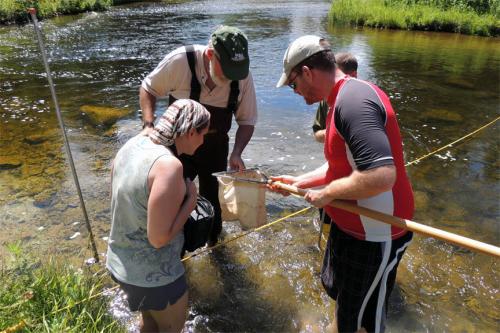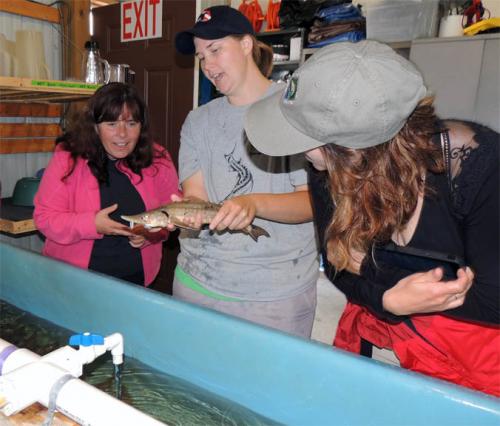Educators explore Great Lakes fisheries science during Lake Huron adventure (Part 3 of 3)
Lake Huron educators study lake sturgeon, gaining a Great Lakes fisheries science experience and opportunity to promote inquiry, science, and stewardship learning with their students.
What’s it like to experience the prehistoric Great Lakes lake sturgeon up close and personal? Ask any of the twenty educators from across the Lake Huron watershed who shared a day this past summer 
Sponsored by the Great Lakes Sea Grant Network and Michigan Sea Grant Extension, the Center for Great Lakes Literacy and Great Lakes Stewardship Initiative, this workshop aimed to bridge Great Lakes science with educational school learning opportunities. Before their visit to the sturgeon research lab, these teachers had already spent a day on the water exploring Great Lakes watersheds. Here, they were introduced to fisheries science and issues (such as aquatic invasive species) with Michigan Sea Grant and learned about methods of sampling fish diversity in Huron coastal wetlands with a wetlands researcher from Central Michigan University’s Institute for Great Lakes Research. On this day, their fisheries studies focused on the native, yet threatened, lake sturgeon, with scientists working to protect this fish species.
- Exploring Lake Sturgeon Research: Teachers explored sturgeon ecology with Dr. Kim Scribner and his MSU research team, learning about their diversity of research projects focused on recovering populations of this fish. A tour of the hatchery provided teachers an up close experience with juvenile lake sturgeon reared at the hatchery, while learning about sturgeon biology from life cycles and genetics. Before the day’s end, educators were back in the river – exploring spawning (breeding) habitat, water quality and aquatic invertebrates (the small organisms on which sturgeon feed) – and linking the study of river habitats to healthy sturgeon populations.
- Fostering Educational Linkages: Teachers gained a valuable perspective of scientific process and how inquiry-based learning are applied to sturgeon research and restoration efforts. They also learned about educational resources relating to the sturgeon, including fisheries lessons and data on the Teaching Great Lakes Science website and, more specifically, a Great Lakes sturgeon education website offering educational lessons and online data specific to the sturgeon research ongoing at this sturgeon lab.
- Bridging Place-Based, Community Partnerships: Educators continued their conversations with research scientists, community partners, and fellow educators – learning that there are many community partners invested in sturgeon stewardship and ready to assist schools in making educational connections with students. Aside from the MSU research scientists, educators met with citizen partner
 s such as Sturgeon for Tomorrow – Black Lake chapter and Huron Pines habitat restoration specialist, Patrick Ertel. Drawing on these community partnerships examples, educators reflected on place-based education opportunities by which their students, through their learning, could contribute to Great Lakes stewardship projects such as these.
s such as Sturgeon for Tomorrow – Black Lake chapter and Huron Pines habitat restoration specialist, Patrick Ertel. Drawing on these community partnerships examples, educators reflected on place-based education opportunities by which their students, through their learning, could contribute to Great Lakes stewardship projects such as these.
Science learning, place-based education, and enthusiastic educators equal an invaluable opportunity to promote, through student learning, opportunities to enhance Great Lakes literacy and a better understanding of the Great Lakes and our interconnections with these water resources. From sturgeon studies to habitat restoration projects, the day provided great examples of science, technology, engineering, and math (STEM) learning applied in practice. Throughout the day, researchers challenged teachers to help their students think like scientists, understanding that there is much yet to be learned about the Great Lakes and this iconic fish. One northeast Michigan educator from Cheboygan Middle School is already capitalizing on these new partners and opportunities to inspire her students through sturgeon science connections in her classroom.



 Print
Print Email
Email

